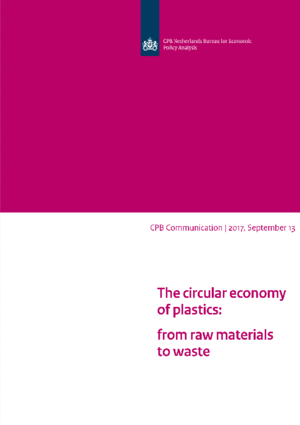The circular economy of plastics: from raw materials to waste
The production of plastics has grown enormously in the past 50 years (to over 320 megaton in 2016) and is expected to increase further in the coming decades. The most important environmental damages caused by plastics are pollution, especially plastic soup, and carbon emissions. The depletion of fossil resources (oil and natural gas liquids) is not an important issue in relation to plastics. Because global sustainability measures in the transport and energy sector are expected to limit the use of fossil resources, a sufficient supply of oil for plastic production is ensured for hundreds of years.
The environmental benefits of recycling household plastics are currently limited. It does not reduce littering or plastic soup. Carbon reduction is limited to about 0,15 percent of total carbon emission in the Netherlands. Therefore, an increase in recycling plastics will not significantly benefit the environment. It is preferable to augment the quality of recycled plastics over increasing the quantity. Plastic waste consists mostly of a mix of different types of plastics and foils, with limited possibilities for new applications. Because of these limitations, and due to the low price of primary plastics (low oil and carbon prices), the retail price for recycled plastics is low or sometimes even negative. The quality of recycled plastics can be increased by improving the sorting of different types of plastics from household waste. However, this makes processing of plastic waste more costly. The current financial incentives are targeted at achieving the highest output of recycled plastics, instead of the highest market value. Therefore, instruments which focus on quality may improve the environmental benefits of recycling plastics. Furthermore, businesses could alter their strategy by using plastics that are better recyclable.
Biobased plastics (plastics made from biomass) can only serve to a limited extent as an alternative to fossil plastic production. Biobased plastics do not reduce littering and plastic soup, because about three quarters of all biobased plastics used worldwide is not biodegradable. Furthermore, for bioplastics to be biodegradable you generally need an industrial environment. The use of biobased plastics may reduce carbon emissions, but at the same time intensifies the use of land and may have side effects on biodiversity and food and energy supply.
Policy measures that help reduce littering and plastic soup could be: extending the packaging deposit system, stricter regulations on the use of plastics (for example in cosmetics), innovation in removing plastics from waste water and measures to reduce plastics in organic waste which is turned into compost. We have not yet investigated whether the benefits of such measures outweigh the costs.
